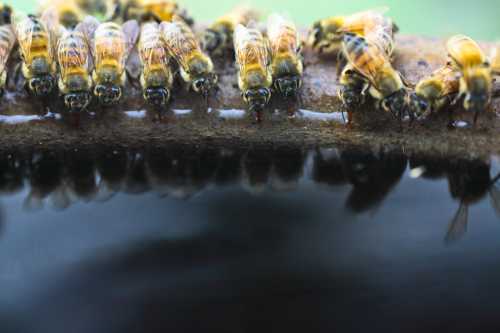Do Bees Like It Hot?
What Temperature Is Best For Bees?
I have received a number of emails, just like this one from Sara in the UK, asking about whether the reason she was seeing so few bees in her garden, might be down to a recent heatwave, during which temperatures were frequently reaching 25 - 30oC, accompanied by a relatively dry spell.
"Hi,
It's been so hot here lately, and my neighbour and I were wondering why we are not seeing so many bees about, especially on our lavender, but also they are not visiting other plants like Echinops.
Do bees like it when it's hot outside, and are we missing the bees because of the very warm, dry weather?
- Sara, UK."
Do Bees Like It Hot? What Temperature Is Best For Bees?
According to one study by Kenna et al concerning bumble bees1, the average distance flown by bees was at its furthest when the temperature was at 24℃. The study also noted that foraging potential might be maximised at temperatures closer to 27℃. Kenna et al commented:
"Subsequently, while mean distance was highest in the 24℃ cohort, there were more successful fliers in the 27 and 30℃ cohorts, meaning that foraging potential at the colony level may actually be maximised at temperatures closer to 27℃."
What temperature is too hot for bumble bees?
When temperatures exceed 27℃, Kenna et al1 note that flight performance begins to be negatively impacted.
However, what is not clear is how such temperatures might affect foraging behaviour of bumble bees when in their natural environment, especially if temperatures were to rise in the longer term. For instance:
- are bumble bees more likely to vary the times at which they might forage for food, according to temperature? For example, will they leave the nest during the cooler parts of the day, such as morning and early evening? There is some suggestion that this may be the case.
- how might temperature affect the usual nectar secretion patterns from plants, and in turn, foraging behaviour?
At what temperature do bumble bees stop flying?
Kenna et al propose that when temperatures rise to 35°C, flight distance could be reduced to under 1km.
They also observed that at temperatures of 15°C and below, bees frequently would not fly past 100m, and not more than a few hundred metres.
 Bumble bee on catmint
Bumble bee on catmintAre hotter temperatures a danger to bumble bees?
Frequency of extreme heat may pose a threat to some bumble bee species. For instance, a study2 of 66 bumble bee species across North America and Europe states:
"Increasing frequency of hotter temperatures predicts species' local extinction risk, chances of colonizing a new area, and changing species richness."
How do bumble bees maintain nest temperature?
Bumble bees have been shown to maintain their nests at a temperature of 28°C to 32°C, and workers may engage in wing-fanning when nest temperatures rise3.
What temperature is best for honey bees?
The optimum temperature for flight activity is 72-77º F (approx. 22 - 25oC, but activity continues up to about 100º F (37.7oC) before declining4.
The minimum temperature for honey bee flight is 54ºF (about 12oC) according to some sources, but this is debated, since honey bees have been observed to forage in cooler temperatures.
Can honey bee hives get too hot?
The optimum temperature for a honey bee hive is 32–36°C (89.6–96.8°F)5.
To prevent hives getting too hot, honey bees fan their wings and collect water to help prevent brood drying out6.
 Honey bee collecting water
Honey bee collecting waterHow Can I Help Bees In Hot Temperatures?
To help bees survive and thrive during heat waves and temperature extremes, follow these simple steps:
1. Safely provide water
Keep a shallow dish of pebbles or bird bath topped up with water. Pebbles enable bees to land and access the water.
2. Keep bee-friendly plants well hydrated
So that plants can offer pollen and nectar for bees, keep them well hydrated so that they don't dry out and die. It's best to water plants in the evening, or very early morning. If necessary, use bath water and even liquid left overs such as tea and coffee on your garden if there is a water shortage.
3. Add drought-tolerant plants to your garden
Some plants are especially tolerant of dry, hot conditions. Examples include ice plant (Sedums), golden rod (Solidago), Spirea, Snowberry (Symphoricarpos albus). See drought tolerant plants for bees.
4. Extend the flowering season
Careful selection of plants can help lengthen the amount of time flowers are available to bees, but remember that dead-heading existing specimens in your border, or leaving clover to flourish in the lawn and sowing a few quick-growing annuals can are simple methods to further extend the flower availability for pollinators.
References
1. Kenna, D., Pawar, S., & Gill, R. J. (2021). Thermal flight performance reveals impact of warming on bumblebee foraging potential. Functional Ecology, 35, 2508– 2522. https://doi.org/10.1111/1365-2435.13887. And: "Bee flight suffers under temperature extremes" - Imperial College London, 2021.
2. Soroye P, Newbold T, Kerr J. Climate change contributes to widespread declines among bumble bees across continents. Science. 2020 Feb 7;367(6478):685-688. doi: 10.1126/science.aax8591. PMID: 32029628.
3. Gardner, K.E., Foster, R.L. & O’Donnell, S. Experimental analysis of worker division of labor in bumblebee nest thermoregulation (Bombus huntii, Hymenoptera: Apidae). Behav Ecol Sociobiol 61, 783–792 (2007). https://doi.org/10.1007/s00265-006-0309-7
4. University Of Maine: Honeybee Flight Activity Index.
5. Daniel Cook, Boyd Tarlinton, James M McGree, Alethea Blackler, Caroline Hauxwell, Temperature Sensing and Honey Bee Colony Strength, Journal of Economic Entomology, Volume 115, Issue 3, June 2022, Pages 715–723, https://doi.org/10.1093/jee/toac034 - Citing Tautz 2008, & Stabentheiner et al. 2010.
6. Madeleine M. Ostwald, Michael L. Smith, Thomas D. Seeley; The behavioral regulation of thirst, water collection and water storage in honey bee colonies. J Exp Biol 15 July 2016; 219 (14): 2156–2165. doi: https://doi.org/10.1242/jeb.139824

